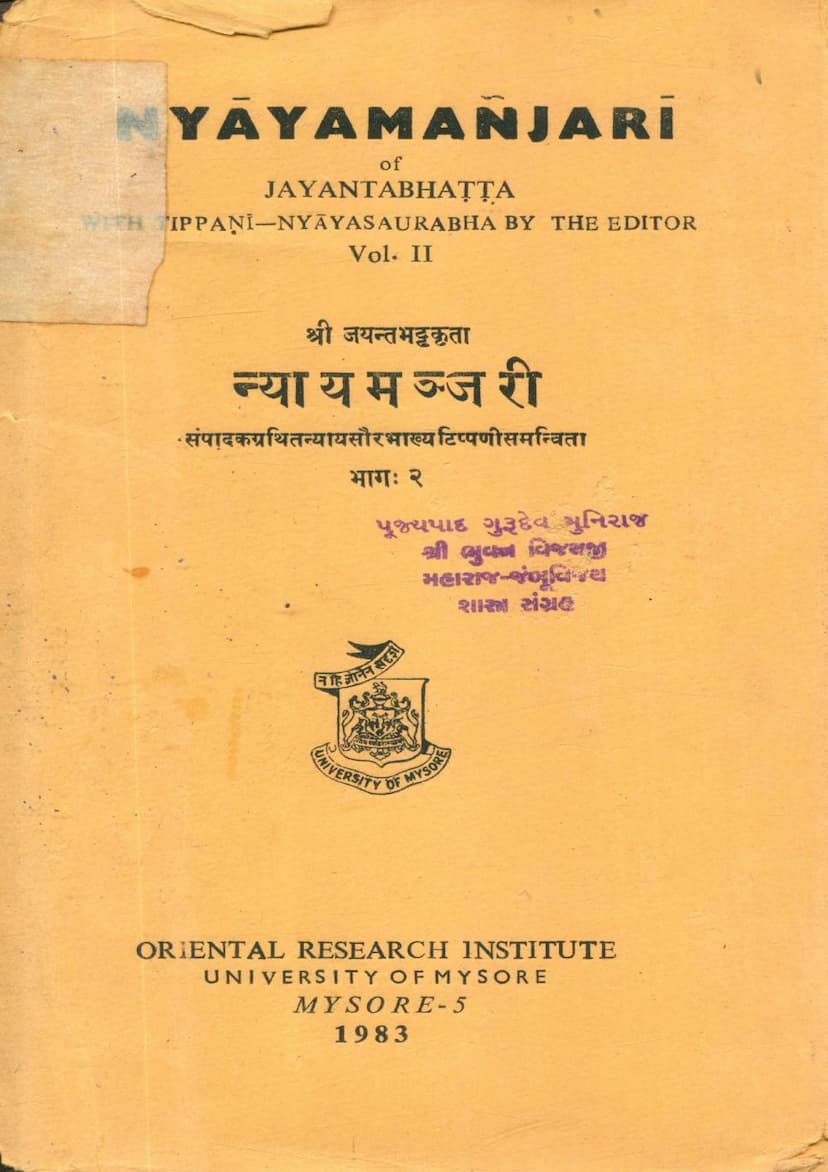Nyayamanjari Part 02
Added to library: September 2, 2025
Loading image...

Summary
This document is the second volume of "Nyayamanjari" by Jayantabhatta, critically edited by K. S. Varadacharya and published by the Oriental Research Institute, University of Mysore in 1983. It is part of the Oriental Research Institute Series, No. 139.
Key aspects of the book and its context:
- Author: Jayantabhatta, a prominent scholar from Kashmir, is recognized as one of the significant figures in Nyāya philosophy. He lived around the last quarter of the 9th century AD, during the reign of King Sankaravarman.
- Work: Nyāyamañjarī is considered Jayantabhatta's magnum opus, an independent treatise based on Gautama's Nyāyasūtras. It elaborates on the key tenets of the Nyāya school of philosophy. The preface notes that Nyāyamañjarī attracted attention from scholars early on, with a commentary called "Nyāyamañjarigranthibhanga" by Cakradhara being a testament to this.
- Volume II: This volume presents the second part of the Nyāyamañjarī, accompanied by a commentary titled "Tippani-Nyayasaurabha" compiled by the editor. The publication aims to meet the scholarly demand for this important work, especially given its perceived quality compared to other existing editions.
- Content of Volume II: The Table of Contents reveals that Volume II covers a wide range of philosophical discussions within the Nyāya framework. It is structured into several Āhnikas (sections or chapters), focusing on:
- Word Examination (Shabdapariksha): Discussing concepts like Jativada (theory of universals), Apoha (exclusion), Padashakti (word power), and Vakyartha (sentence meaning), including extensive debates on theories like Sphota.
- Reality Examination (Prameya Pariksha): This forms the bulk of the volume, delving into the nature of the Atman (self), body, senses, intellect, ego, consciousness, the reality of knowledge, the Mādhyamikas, the authority of Agamas (including Buddhist ones), the acceptance of bliss in Ishvara, the rejection of super-sensory perception (alaukika sannikarsha), and the assertion that only the body appears in egoistic knowledge. It also discusses theories of atomism, causality (Pīlu-pāka vs. Pithara-pāka), the soul, the self, the soul's immateriality, the soul's consciousness, the soul's knowability, the soul's self-luminosity, the soul's non-consciousness, the soul's direct perceptibility, the soul's inferability, the kevala-vyatireki (exclusive negative) argument, the theory of Pīlu-pāka and Pithara-pāka, the soul's non-materiality, the soul's lack of consciousness, the soul's perceptibility, the soul's inferability, and the kevala-vyatireki argument. It also critically examines the concepts of pretyabhava (afterlife), atomic origin of the universe, and the examination of phala (results) and dukkha (suffering).
- Apavarga (Liberation): Critically analyzes the doctrines of Advaita Vedanta, Buddhism, and Jainism regarding liberation.
- Doubt and Reasoning (Samshayaadi Pariksha): Discusses doubt, classification, causality, purpose, examples, establishing theses, syllogism, exclusive positive arguments (kevala anvayi), exclusive negative arguments (kevala vyatireki), fallacies, sophistry (chala), and arguments (jalpa, vitanda).
- Universals and Other Concepts (Jati aadi Pariksha): Explores the theory of universals (jati), similarity and dissimilarity (sadharmya vaidhirmya), concepts of excellence and deficiency (utkarsha apakarsha), modification and change (vikara), cause and effect (karya), possibility and impossibility (prapti aprati), inference by example (prasanga) and counter-example (pratidrstantasama), non-origination (anutpatti), doubt (samshaya), sections (prakarana), fallacious reasoning (hetu), explanation (arthapatti), finding and non-finding (upalabdhi anupalabdhi), eternity and non-eternity (anitya nitya), and cause and effect (karya). It also covers the six methods of refutation (shatpakshi), and the twenty-four logical fallacies (nigrahasthana).
- Editor/Commentator: Vidwan K. S. Varadacharya, Research Assistant at the Oriental Research Institute, Mysore, is credited with both the critical editing and the valuable commentary (Tippani-Nyayasaurabha). He also provided assistance after retirement to ensure the publication's completion.
- Publisher: Oriental Research Institute, Mysore.
- Date of Publication: 1983.
- Praise for Jayantabhatta: The preface highlights Jayantabhatta's superb mastery of Vedas, Mimamsa, Vyakarana, Nyaya, and Buddhist works, combined with his poetic abilities. His sense of humor, vast vocabulary, and intellectual maturity are evident throughout Nyāyamañjarī.
- Key Philosophical Points Discussed (as per preface):
- Acceptance of Sankhya in qualities (contrary to the dictum that a quality cannot possess another quality).
- Acceptance of bliss (ānanda) in Īśvara (God).
- Rejection of super-sensory relation (alaukika sannikarsa).
- Assertion that in egoistic knowledge (aham), only the body appears.
- Assertion that even Mādhyamikas accept jñāna (knowledge) as a reality (tattva).
- Acceptance of the authority (prāmānya) of āgamas (including those of Buddhists).
- Overall Purpose: The book is a critical edition of a seminal work in Indian philosophy, providing scholarly access to Jayantabhatta's profound insights into the Nyāya system, enhanced by a contemporary commentary.
The text provided is extensive, covering the fifth Āhnikam which focuses on the "Examination of Words" (Shabdapariksha). This section delves deeply into the nature of words, their relationship with meaning, the concept of universals (jati), grammatical analysis, and various theories of sentence meaning, often engaging in detailed debates with Mimamsa and Buddhist philosophical positions.